Any outdoor activity comes with potential small threats—things like sunburns, stormy weather, poison ivy, or twisting an ankle! But what about those yellow and black striped flying insects that we see? What are those things? Your first guess might be “It’s a wasp! I don’t want to get stung!” and while it might be a dangerous wasp, it could be something else. We’ve written up this short guide to all things flying, striped, and bi-colored yellow and black! Read below about the most common bees, wasps, and impostors that you might see while you are out for a hike. We’ve listed them alphabetically and included some photos so that you can best identify that creature!
Agapostemon Sweat Bee.

2013 Sean McVey
Can they sting? Yes, but they are not aggressive.
These bees have distinct markings. Males have a green head with a black and yellow striped body. Females are less colorful, being mostly just green. These bees nest in the ground, but are attracted to sweat (hence the name) and will land on sweaty exposed body parts (arms and legs).
American Bumblebee.

2008 Tommy Peck
Can they sting? Yes, but they are not aggressive.
Easily identifiable by their large, fuzzy bodies, bumblebees are some of the best pollinators that exist in our forests and gardens. They seek out rich nectar and can often be seen carrying visible pollen on their legs. If you see a bumblebee, let it alone! Not only will they ignore you, but they are a population in decline that needs protection and they are important for pollination of plants that birds and wind cannot help.
Cicada Killer.

Can they sting? Yes, and will when highly threatened. Human attacks are rare.
As the name implies, these bugs feed on cicadas. They are identified by large black bodies with 3 partial yellow stripes across the back. Cicada killers are wasps and not bees, they nest in the ground. If you find a nest in your yard on the ground, avoid the area. Stepping on the nest may agitate the wasps and they may sting in defense.
Common Eastern Bumblebee.

2013 T. Mayer
Can they sting? Yes, but they are not aggressive.
These are the most common bees that you will see in North America. They are large, fuzzy, and have a single band of yellow around the waist. They have a black head with yellow hairs on the thorax and they are loud. Like the American Bumblebee, these creatures are so important for pollination so leave them be!
Eastern Carpenter Bee.

2007 Ted Kropiewnicki
Can they sting? No, they can’t hurt you.
These bees are identified by a large black head and a yellow thorax. They have strong jaws, allowing them to cut into wood, such as a shed or fence. When threatened, they will fly aggressively around the threat in an attempt to scare it away, however they cannot sting.
Eastern Tiger Swallowtail.

Can they sting? No!
Not a bee, but a bee-utiful butterfly! Not all yellow and black striped flying creatures are scary!
Eastern Yellowjacket.

Can they sting? Yes, their stingers contain venom and can sting multiple times.
This is an insect you want to avoid! Yellowjackets are wasps, who nest in the ground and are highly defensive. Yellowjackets are attracted to sweet substances, like candy or soda, so be careful when enjoying beverages outdoors (don’t get stung on the lip).
Do not physically attack these creatures. When attacked, yellowjackets release a pheromone that signals to other yellowjackets to come help attack the threat. Your single opponent battle will soon become multiple yellowjackets and potentially dangerous. Walking (or running) away from a yellowjacket is the best defense.
Download our FREE trail chart—19 of the best hikes in the Blue Hills detailed for you!
Five Banded Thynnid Wasp.

A male with a large, psuedo-stinger. 2015 Lloyd Davidson
Can they sting? Males cannot sting (they have a large fake stinger), however females can sting.
These are medium sized wasps with full length stripes. Males tend to have white and brown wings, while females have orange wings. These wasps lay eggs on beetles, and the offspring will eventually eat the beetle. They are typically found in gardens and meadows.
Flower Fly & Hover Fly.

Can they sting? No, they are harmless.
These harmless wasp look-a-likes can neither bite nor sting. They have large eyes, like a fly, making them easily identifiable compared to real wasps and bees.
Honey Bee.

Can they sting? Yes, however they are not aggressive and will lose the stinger and often die after.
Honey bees can be either worker bees, drones, or the Queen bee. These bees are a mainstay of the ecosystem as we know it. They create hives out of wax and live in large colonies. These bees are critically important, please do not disrupt them or swat at them!
Paper Wasp.

Bruce J. Marlin
Can they sting? Yes, if provoked. They can sting multiple times.
Paper Wasps prefer to nest in wood, such as a shed or fence or a pile of firewood. They are social dwellers and will defend their home to intruders, so be careful if you have a nest in your shed or barn. However, if you like to garden, these wasps are great at removing unwanted caterpillars from your crops!
Potter Wasp.
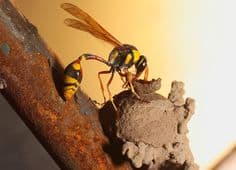
A potter wasp and it’s dwelling
Can they sting? Yes, but rarely does.
These wasps build nests that look like ceramic pots, using mud and twigs to build structure. They typically prey on spiders, beetles, and caterpillars.
Robberfly.

A robberfly eating a yellowjacket. John Segal 2015
Can they sting? No, they have no stingers but will deliver a painful bite if caught.
Robberflies look similarly to yellowjackets, but they only show aggression towards other insects, including yellowjackets! They are easily identified by their bright yellow and black markings, and their signature “beard” on their face. They have a black thorax with two yellow “eye” markings in the middle. Don’t be afraid of these flying insects!
Now that you have the knowledge about some of the flying insects to avoid (and some to ignore), download our free chart to the Blue Hills, where you can learn about 19 of our favorite hikes in the Blue Hills! Let us know if you see any yellow and black striped flying insects while you are out!

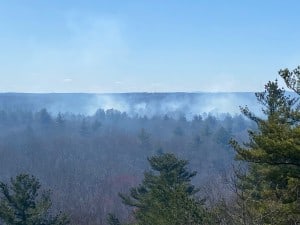




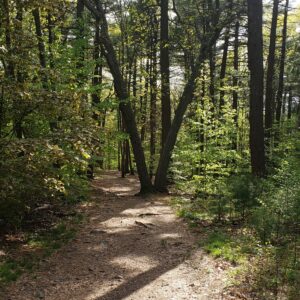




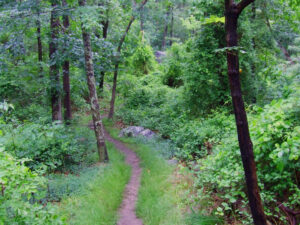
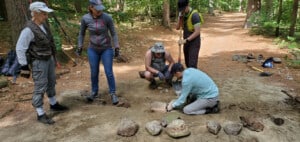

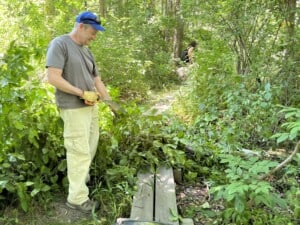

There’s a wasp in my kitchen, I think it’s a wasp anyway, it’s got 3 body parts, the head, middle bit and the but and it’s but is striped yellow and black but the head and middle are fully black, I don’t know what it is
Thanks for your comment. It’s hard to tell what that could be.
I think that’s called a Cicada Killer Wasp. Don’t take my word for it. Because I’m not entirely sure.
I have a photo of a bee I’ve never seen before! Reminds me of a cross between a honeybee and bumble bee. Long wings. HUGE black eyes. I’d love to submit a photo. How do I do that?
Why don’t you post it on iNaturalist and see what people think it is?
Found this today, flies like a hummingbird with 2 yellow and black rings on it’s bum and a long thingy coming from it’s nose that it goes into flowers with. I took 2 videos of it, 1 is in slo-mo
Wow! Thanks for sending the videos. Where do you live?
So in my indoor garden I found a strange looking wasp looking bug. Not quite sure what it is! Would you be able to help identifying this bug?? It was skinny and thin. Very thin. Maybe a baby? Black and yellow with long antennas
Good question! I’m afraid we’re not sure what your bug is!
I’m pretty sure that’s called a wasp beetle. I’m not entirely sure though, so go look at pictures.
I was stung yesterday by a large, striped yellow and black wasp. I am not sure what kind it is but my lower leg is horribly itchy and my ankle is so swollen that I cannot see my ankle bone and I am thin and boney. I am not sure what kind of wasp it is but I have been seeing them all summer. I can barely walk and it’s a drag because I have a lot of yard work I need to do.
I live in Central Oregon at a fairly high altitude. It is referred to as High Desert.
i have found in my yard large fuzzy bee with black body yellow head and one yellow ring around the its butt
I also noticed a larger than normal insect today. Aprox. 2in. Long, half width of my thumb. Fuzzy body, multiple thick yellow bands around butt(thorax). Yellow jacket/wasp-like wings, not extending completely to end of body. Was seen just prior to sun up, Western NY
Sounds so interesting.
Amazingly i was searching for this description. I am in central nj and saw this first time. Will like to know the name and f this and also can they sting. They’re in abundance this year from last 2 weeks
What does a muder bee or killer bee look like.Also have seen a lot of bees and wasp the size of the palm of my hand
David – Do you mean ‘murder hornets?’ We’re not familiar with them but can ask around. Thanks so much for your comment!
I have an old pot that had a hole and I see little black and yellow insects fly in and out. They do not have the shape of a wasp but have the same color which cancel out bees. Should I be concerned and how can I remove the potential nest?
Great question! You might want to ask a pest control company for help.
It’s incredible the amount of increase in the different species this year. Tlthere’s medium/sm size black bees living in the couch. Smaller black bees that’s in the little holes in the walls. Yellow jackets, possibly multiple species live in the big Palm tree, under the eaves and the drainage ducts. Also an occasional honey bee. Today I saw the green one.
My question is where did all the different bees come from this year? Did people stop using the bug sprays?
Thanks so much for your question! We’ve passed it on to a bug expert, and will let you know when we hear back!
Okay, one bug expert responded with this: There has been no observation of a general trend, just a lot of anecdotes. If anything, we should be seeing LESS insect activity due to the drought.
Such a good question!
Are there killer bee’s in FL? Think I saw one
We don’t know. A good thing to investigate.
I just saw something that
looked like a cross between a bumble bee and a humming bird. It was larger than a bee, had 2 wide bright yellow stripes across its posterior segment and what looked like a needle in front which it used to gather nectar. Never saw anything like it before. Anyone have any ideas what it is?
Sounds quite interesting! We can’t say that we have seen that before.
Could it have been a hummingbird moth? I’ve also heard it called a hummingbird hawk moth. They’re really unique looking!
Just saw it today! I took 2 videos of it and I’m sending them to this website’s email
Green metallic torax*
THERE IS A WASP HERE N THIS 100 YEAR OLD CABIN THAT LOOKS LIKE NO WASP I HAVE EVER SEEN!!! IT IS BLACK WITH YELLOW EYES SMALL STRIPE DOWN THE BACK??? COULD SOMEONE PLEASE TELL ME WHAT THIS IS?
Sounds interesting! Where is the cabin?
Do you want to send us a photo and we can forward it to an entomologist? You can email: info@friendsofthebluehills.org.
I discovered a colony of something related to bees in my vegetable garden. There were approx.10 of them that made holes in the soil and they had a distinctly-loud hissing sound. Curled up in hard black shells with yellow stripes, they dispersed, flying & crawling away.
Can you please tell me what this is/Does it sting? Can it contaminate soil/make it unsuitable to grow food? I am reluctant to start planting vegetable seeds until I have answers. Thank you
We’ll look into it and get back to you!
Monica,
We have gotten a lot of responses. I am going to email you the possibilities.
Thanks for contacting us!
– Judy
I have swarming black/bee size I guess wasp. They have 4 to 5 yellow strips on there back of there body. I have grown up patches around the back yard, pine straw, oak leaves. How do I get read of them and do they sting?
Great questions! I’m afraid we don’t have great answers for you. Sorry!